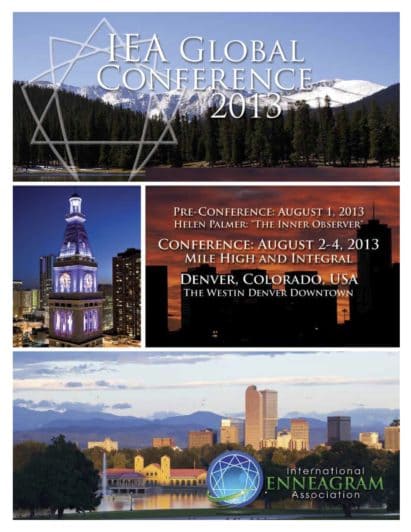Before describing the Pre-Conference Day session I’d like to share what I learned at Ken Wilber’s 2013 Conference. The initial impression was seeing over 400 international participants get themselves up a very cold mountain in mid-winter. The second was hearing how committed they are to the Integral map of consciousness. The third realization was that my Enneagram keynote was greeted with a certain ambivalence. Would the E map be just another typology? But all that changed when they saw a slide show about the Enneagram’s cosmological origins. Their evolutionary perspective didn’t flinch at the image of nine eternal Archetypes beset by human passions. And they correctly saw the panel interview as a current expression of how the passions show up today. Yet I was still uncertain about the fit between our communities until it came to the didactic and practice periods. When a hall gets that attentive it creates a welcome field of gathered presence. This Pre-Conference Day session is a fuller version of the Integral keynote. It presents the slide show of where the Diagram came from, the information it conveys, and how it reads through the current lens of neuroscience and psychology. Brain mapping illuminates the interior landscape of conditioned patterns that unseat spiritual states. These are the same patterns that can be internally recognized by a vastly underused faculty of knowing commonly called the Inner Observer. About the Inner Observer It seems only natural to observe the patterns of our mind and to hear the self-reports of people who see the world differently. Yet that simple turn of attention that self-reflection requires marks a giant leap in the evolution of consciousness. The first turn lets us witness our personality structure. We can observe our thoughts as we are thinking and tell them to someone else. We can witness our emotions as they arise and describe them to others. Self-reflection is the bedrock of evolving consciousness. Self-reflection led you to your Enneagram type. In the vocabulary of spiritual practice we can learn to recognize the patterns passing through our mind –thoughts, emotion, sensation–“objects of attention” that are structured according to type. Yet the “pure knowing” that notes those patterns as they arise makes prayer and meditation possible. In the language of neuroscience self-reflection joins two different levels of consciousness. The conditioned level of patterns embedded in the neuropathways of our brain, and a reflective state of mind that activates when pre-frontal dominance recedes. From an evolutionary standpoint we can voluntarily observe the automatic responses that drive our type in a predictable direction. We can learn to recognize and relax embedded cognitive “neuromarkers” such as doubt, flattery, deception and judgment– before they become utterly convincing. These capacities of mind demonstrate our voluntary role in the evolutionary arc of consciousness. For who but ourselves can relax the passions that drive us instead of letting them run? To get the most from this level of learning, participants should know their type and be somewhat skilled in self-observation.
Helen Palmer
2013
2013 IEA Global Conference
Denver, Colorado, USA
Note that you must log in with your individual member account.
Accredited Enneagram School (AES) accounts and Accredited Training Program (ATP) accounts are no longer supported.
Please log in with the individual sponsor account instead in order to make changes.
If you believe this is an error, try signing out and signing in again.



